Вы здесь
Talapty ancient settlement.
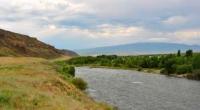
Archaeological researches, which let to estabIish the time of settlement of valley, starting from the bronze epoch has been carried out intensively during the last two tens years. On the right bank of Koksu River Koksu from the canyon No.8 up to the canyon No.10 the settlement and burial grounds of bronze epoch, which got the name Talapty have been discovered. As the rule, the settlements and burial grounds were situated on some distance of each other (300 - 400 m) and were established on the upper part of Koksu river terrace, on the plain place.
Talapty settlment was discovered in 1982,in 1985 excavations headed by A.N.Mariashev had been started. Stone laying of rectangular form had been observed on the surface of settlment, fragments of grain graters and some stone pestles had been collected before the beginning of excavations.
The most part of settlement was washed out by river. Some earth-houses and one big house in size 16 x 18 m deepened into the earth on 1 m were cleaned out on the section. Entrance into it had «r» shaped form.
The oven of rectangular form in size 2,4 x 2,2 m was situated in the center of dwelling and was formed of plates put on the ribbon, it was filled by ask. The pits were digged up to the east from oven.
One of pits was put by plain stones; supposively it was the storage-pantry. The second pit was filled by animals’ bones and fragments of broken dish, apparently that it was the pit for rubbish.
Laying of big stone, filled by ask in prolongation of 15m аnd width 1,6 m was situated along all northern wall. People stoked by «black» method and ask had been put over the stone to keep the warmth till morning.
The smoke went out through the hole in the roof and apparently the roof had been bumt very ofien. So, the bumt boards and coals are very frequent finding during excavations of settlements.
Stone layer covered by ash, is the prototype of sufa by its form. The people worked and had rest on them. Stone pestles, pieces of copper ore, bone edges of arrows of leaf shaped form, rolls, pipes, bone nails, polished stones with grooves for binding of ropes had been discovered there.
The last ones (bolaso), were used for catching animals, during throwing the rope hardened by stones, tied the legs of animals. A lot of other utensils had been found on the floor of dwelling: grindstones, knife shaped plates, stone knives, scrapers, hoes, covers of vessels, spins.
Two safe ceramic vessels had been found at the entrance to the premise from the east in small niche, made in the wall from outward side. One of the pots was put into another of bigger size.
Apparently these vessels and their content served the specific amulet for house. Fragments of ceramics dated by the period of late bronze the end of the 2 - early I millenium B.C. had been collected on the floor of premises.
The settlement Talapty existed during a long period of time, and its insinhabitants led the complex cattle-breeding-agricultural economy. By the material the settlement was of one layer. Ceramics is close to Sargara monuments late bronze by some features it is also close to the ceramics of settlement Kent from Central Kazakhstan.
Burial grounds Talapty–I and II gave also the interesting material. Burial ground Talapty-I is situated in the upper terrace of Koksu River, in 3 km to the north from the village Talapty. 18 burials had been found and excavated.
Burial ground consisted of the separate stone fences. Three variants of burial constructions existed in the burial ground Talapty - I: boxes (10), boxes – cists (6), cista (2). In comparison with boxes, cists were made of stone plates put horizontally. Mainly the burial cameras directed by the axis west-east, were surrounded by fences.
The burials were made by the ceremony of cremation (burn of corpse) (3), ingumation (corpse putting) (11). The burials by tradition of ingumation were carried out in writing position of the left side. The pot was put at the head.
Except ceramics, material is presented also by beads. Burial ground Talapty- II is situated in 400 m to the west of burial ground Talapty- I burial ground consists of the separate fences of quadrangular and rectangular forms. With 1 - 2 burials. 20 burials had been excavated in the burials cameras of four types: 1-in ground pits (4); 2- in ground pit with rectangular laying on the bottom (5); 3-in boxes (1- cases; 4-in cista (1).
Almost burials are directed by the axis west-east and were done by the ceremony of ingumation in writhing position on the left side, with the head to the west. The pots were put at the head.
Ceramic vessels, bronze beads, pins, pendants, and ear-rings had been.found in the burials. Ear-rings are made of thin bronze sheet rolled into hollow small pipe of the organic basis. One end is sharpened comes into pipe shaped widening of another.
Diameter of ear-rings is different - 4,5 and 3 cm. The smaller ear-ring is made by the unusual method: the organlc basls was covered by gold foil, with bronze sheet above it. Appearance of such metal items by the form as well as by the technology of production wasb observed on the territory of Kazakhstan not earlier than XIV - XIII c.c. B.C and is connected with the spread of east Kazakhstan and Alatau traditions.
The analogous to the ceramics of Talapty are observed in Fyodorovsky complexes of East Kazakhstan, Southern Syberia and Kirgizia. Similar forms and ornamentation of vessels are met almost always together with roller (Sargary) ceramics what is confirmed by excavations of Talapty-I.
These data let to date the time of functioning of burial mounds Talapty-I and II by the boundary of the II-I milleniums B.C the previous anthropological analysis are the evidenceson belongship of the dead to south Siberian type of European race.
A little different material is from the burial ground Talapty-III, discovered on the territory Talapty-I settlement. Burial ground presents themselves the stone fences with one grave of adult man inslde.
From the outward sizes of fences the boxes with burials of children had been built. Burial eonstruetions on the burials are presented by stone boxes and boxes-eists. All burials on the burial ground Talapty - III were made by the ceremony of ingumation in writhing position on the left or right side, with the head to the west (south-west).
At the faeial side of skull the ceramic pot was usually put. Vessels in a form of jars and pots had been diseovered in the burials. Ceramies with similar features is rather widely spread in the materials of Alakul monuments of Central Kazakhstan which are dated in the frames of the XIII - XII c.c. B.C. by the elosest analogues from Semireehie monuments Oy-Djailau and Tamgaly we can correlate the materials of this burial ground with the late Alakul time and to date it in the frames of the XIII - XII c.c. B.C.
On the right bank of Koksu river between the eanyons No.11 and No.14 one more archaeologieal complex of bronze epoeh Kuigan eonsisted of settlement and three burial grounds had been diseovered.
Settlement Kuigan-I is situated on the right bank of Koksu river, 10 - 12 m higher the river level, at the plaee of Ashibulak stram flow into the river. On the surfaee were observed only burial mounds of a big sakae burial ground, but in the plough field andon the slopes of terrace the numerous fragments of bronze epoeh eeramies and bones of animals had been discovered.
Two shafts were put, whieh eonfirmed the presenee of the essential culturallayer of bronze epoeh. The material received in the result of exeavations let to consider that it existed at the same period as settlement Talapty-I.
Big investigations had been carried out on the burial grounds Kuigan-I and II, where had been excavated about 30 fenees of bronze epoeh. The burial grounds are situated in the region of Kuigan canyon.
If the burial ground Kuigan-I consists of the separate stone fences of quadrangular and rectangular forms, with fixed inside burial in stone box, the burial ground Kuigan-II is different. In its central part are fixed the fenees analogues by the type to the burial ground Kuigan-I, and the fences of west part of burial grounds are distinguished essentially.
From two up to seven burials inside eaeh fenee, divided inside for several sections had been discovered in them. The analogues construetion of over grave eonstruetions is observed in Semireehie, first of all in the burial ground Karakuduk and Tamgaly-III.
Ceramies from the burials is various by the form and method of produetion. All vessels are divided into jar and pot shaped ones with round shoulder or ledge, mostly without ornament. The most charaeteristie is the dish with high and narrow support, having the analogies in the burial ground Tau-Tary from South Kazakhstan of the late bronze epoch.
Three plait decorations of leaf shaped form, bell-shaped ear-rings and bronze beads had been found on the burial ground. All set items comes from the burial 1, fence 20. The most charaeteristie deeorations for Semirechie bonze epoeh monumentsare bell-shaped ear-rings.
Ear-rings are casted and by the point of view of the majority of specialists, are referred to the eastern Fyodorovsky tradition of Andronovsky cultural-historical communuty. This situation, when Fyodorovsky and Alakul features in the materials for Semireehie are combined in the burial eomplexes is characteristics in the monuments dated in the frames of the XIII - XII c.c. B.C. apparently by this time is necessary to define also the beginning offunetioning of the burial ground Kuigan-II whieh in future existed for a long time enough.
The burial complexes Kuigan are of different times and contain not only the burials of bronze epoch, but of early Iron Age, middle age and the Kazakh time. Moreover, the burial mounds of early iron age are met in a region of Eshkiolmes ridgeon the right bank of Koksu river, starting from the canyon No.3 and are prolonged continuously up to the canyon No.14, where the river branch is making the turn and goes out from the ridge.
Further the burial grounds are met only at the exit from each following canyon, up to the following canyon close to the lowering of the ridge, usually on the west bank of dried streams. The burials of early Iron Age had been studied on the burial grounds Kuigan-I and Kuigan-II.
Totally a burial mounds in diameter from 3 up to 11 m and in height from 0,3 up to 1,5 m had been excavated. The burials are not deep, up to 50 cm on the burial ground Kuigan-I. The burials are robbed, but it was a success to define the position of dead, they laid in the stretched position, with head to the north-west.
The material was absent, at the exception of pasta bead of byconical form. On the burial ground Kuigan-II the burial with hole from the side, made from the northern part had been excavate Fragments of ceramics and boxes of small cattle had been found in dromos.
The dead were buried in the stretched position, with the head to the north-west. Ceramics of burials is presented by the vessels of jar and pot shaped forms which are dated by early Iron Age.
Moreover, the remains of stone constructions of single Kazakh dwellings had been found at the exit from the canyons 12,14,18,22. It was a success to clarify that in the region of concentration of petroglyphs in pretop part of a ridge the separate dwellings were put as well as complete villages which amounted up to 20 constructions.
They are typically winter sites in the closed from the wind mountainous canyons, on the squares in southern exposition. The settlements are situated in the regions of season springs acting usually from the late autumn up to early spring.
Big villages are situated in the upper parts of canyon No.12, 14, 18, 19, 22. In the canyon 18, above the village had been discovered the Kazakh burial ground which occupied all territory of a small pass.
The first previous archaeological researches showed that they functioned not one time during the late Middle Ages and ethnographical timon which notify the findings offragmen of big vessels like khumcha and porcelain kese.
But it is not excluded that the first settlemen appeared even in the early Iron Age. Taking into account the numerous archaeological monumen of Djungar Alatau and its spurs, the conclusion can be made that settling of Koksu river valley was started from the XIV century B.C.
But the main part of valley was assimilated later, on the bounder of the late II -early I millenium B.C. The life was continued here in the epoch ofearly Iron Age, in the middle ages, in the new and the newest time. The petroglyphsare referred also to the periods of settling.
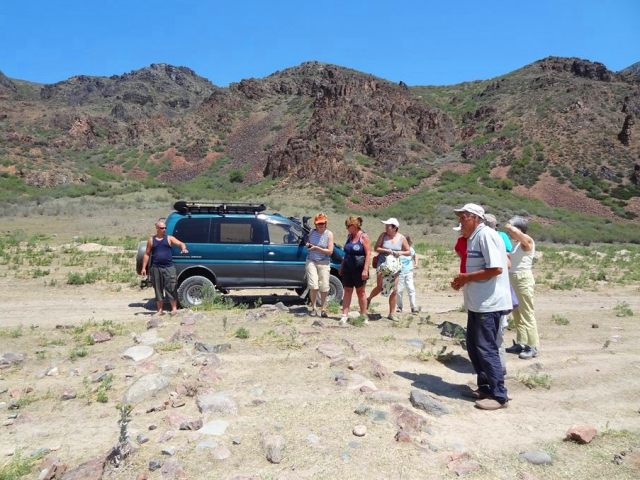
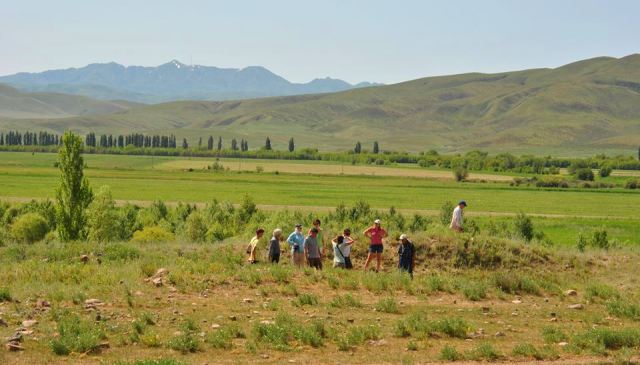
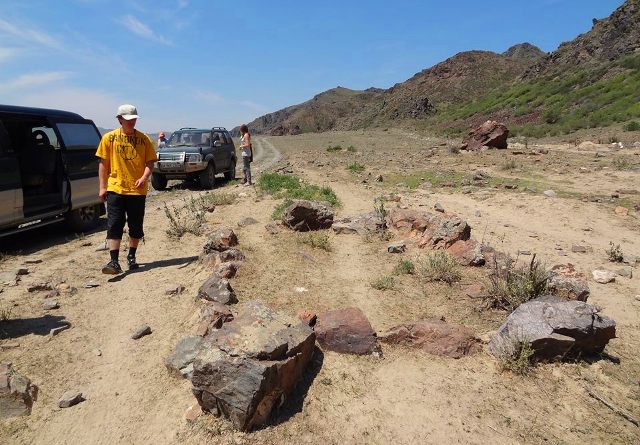
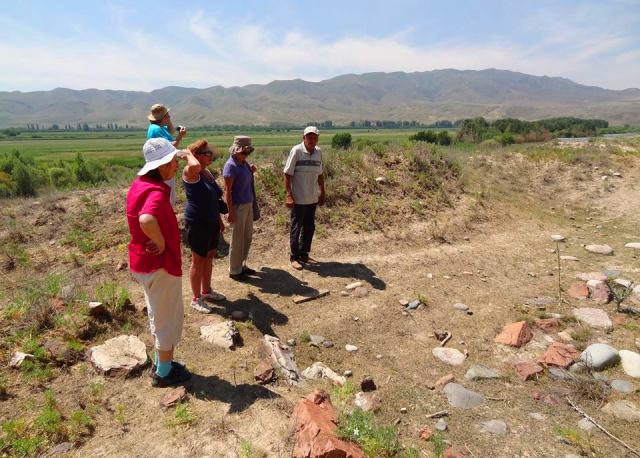

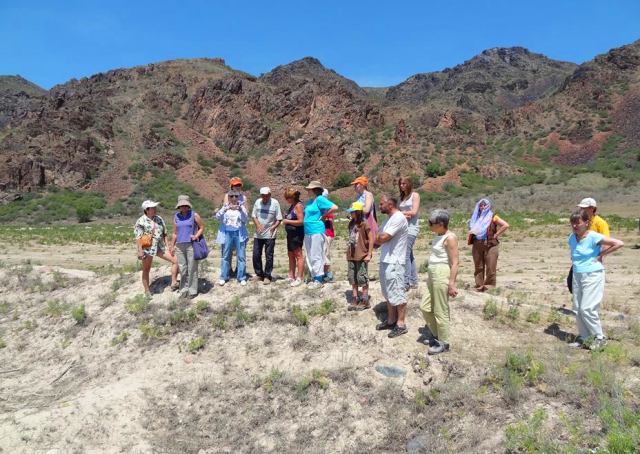


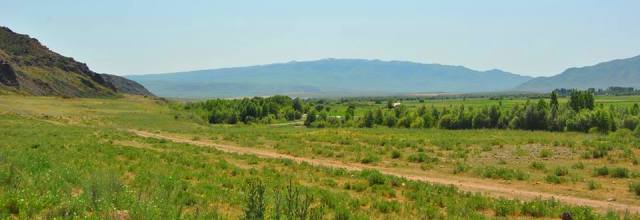
Authority:
«Petroglyphs in Eshkiolmes mountains».K.M. Baipakov,A.N. Maryayshev, S. A Potapov, А.А.Gorychev.Almaty. 2005.
Olga Gumirova and Alexander Petrvov
photos.







